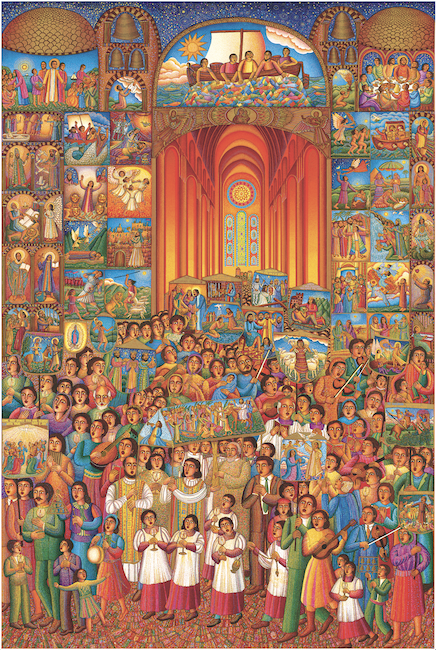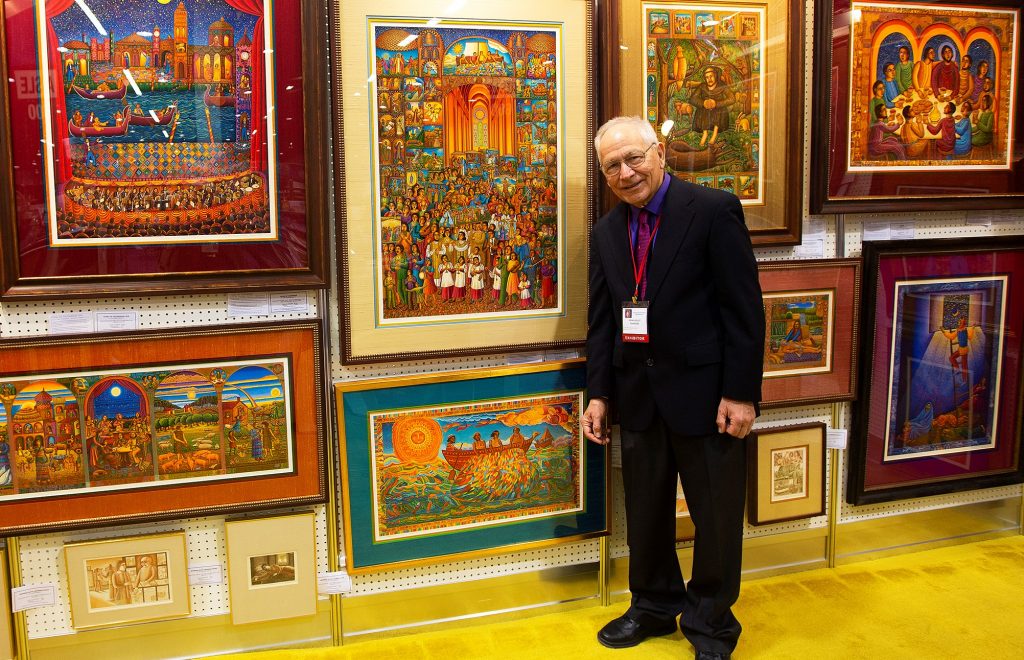In his own humble words, John August Swanson once called his distinct narrative artwork “my most social act.”
Brilliant and simple, giving visual context to Bible stories and themes of justice through acrylic, oil, watercolor, and mixed media, the Los Angeles native’s engaging prints became familiar to those over the years visiting exhibits at the Cathedral of Our Lady of the Angels, meeting him at his vendor booth at the Religious Educational Congress, or just admiring the covers of the Archdiocese of Los Angeles’ English and Spanish-language print publications.
After a battle with congestive heart failure, Swanson died in the early morning of Thursday, Sept. 23, at the St. John of God Retirement and Care Center in the Jefferson Park area of LA. He was 83.
Swanson's award-winning serigraphs, lithographs, and giclée prints resonated for more than 50 years as much globally as locally. His painting entitled “The Procession” is at the Vatican Museum’s Collection of Modern Religious Art. Others hang in galleries in London and Paris. His pieces are in the Smithsonian Institution’s National Museums of American History, American Art, and Air and Space. His painting “Entry Into the City,” representing an article titled “Who Was Jesus,” was used on the cover of Life magazine’s December 1994 issue and is on display at the University of Notre Dame.

The August 2021 edition of the Los Angeles Catholic Worker’s “Catholic Agitator” used Swanson’s 2020 “Song of World Peace” poster on its cover for an issue dedicated to pursuing nonviolence. The Catholic Worker has nearly a dozen Swanson works in its community facilities.
Cecilia González-Andrieu, a professor of theology and theological aesthetics at Loyola Marymount University, is a self-proclaimed Swanson scholar who has worked on projects related to his art and life. She was also his neighbor — both lived near the LMU campus — and considers him “the most generous human being I have ever known.
“He listened intently to the story of the doctor who cared for him and the custodian who cleaned the floors — they were both equally precious to him,” Gonzalez-Andrieu told Angelus. “He chose to work on serigraphs so his art could be available to more people, not just museums and collectors with big budgets, but to everyone and he gave a lot of it away. He believed in a God of absolute abundance who made God’s self present in the miracle of an apple from his tree, in the mystery of eucharistic closeness to the divine, and most of all in each other.”
Swanson had been a regular guest speaker for Gonzalez-Andrieu’s class, “Meeting Christ in Faith & Art,” and his work is featured in her 2012 book, “Bridge to Wonder: Art as the Gospel of Beauty.”
Born Jan. 11, 1938, in the Boyle Heights area of Los Angeles, Swanson had a mother who was a Mexican garment worker and a father who was a Swedish vegetable seller, both in search of a better future. With his father eventually absent from his life, Swanson grew up with his grandmother, mother, and older sister, who passed on the Catholic faith to him through Mexican tradition.
He struggled with dyslexia, eventually left San Gabriel Mission High School and, at age 15, with a desire to become a religious brother serving the poor, petitioned to enter an Ohio monastery. He was sent home after a year.
He found his way to Westchester’s Loyola University campus in the late 1950s with new aspirations of becoming a medical doctor. He could not complete his courses.
Still seeking meaning to his life in his early 30s, and having taken a night job at a paint factory, he enrolled in an art class focused on lettering and printmaking offered by Sister Corita Kent at Immaculate Heart College. Her vibrant serigraphs in the 1960s focused on peace and social justice concerning poverty, racism and war, and were drawing international acclaim.

At his JohnAugustSwanson.com website, his unique style using Mylar film, stencil, and silkscreen is described as “detailed, complex, and elaborate. It is influenced by the imagery of Islamic and medieval miniatures, and of Russian iconography; the color of Latin American folk art; and the tradition of Mexican muralists. ... All his parables optimistically embrace life and one’s spiritual transformation.”
As many as 89 colors of transparent and opaque inks could be found in one of his handcrafted serigraphs. In 2005, Swanson was one of 33 inaugural recipients — along with St. Pope John Paul II and Bishop Desmond Tutu — of the Mother Teresa Award for Social Justice, recognizing “achievements which beautify the world.”
Until his illness, Swanson could be found at daily Mass early each morning at LMU, and played the violin for larger liturgies.
On Aug. 31, Loyola Marymount University recognized Swanson’s work with the LMU President’s Award, a framed proclamation by President Timothy Law Snyder and the highest nondegree recognition the university can bestow.
“This is a very exciting moment in my life that someone would record,” Swanson responded in a handwritten note. “To be looked at not only on one level but on other levels, not just art but my work for justice and faith.”
Funeral arrangements are pending the completion of the renovated Chapel at St. Camillus Center, which will feature a large collection of his works. In lieu of flowers, donations may be made to St. Camillus Center for Spiritual Care or to a local Catholic Worker hospitality center.

